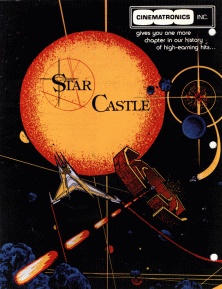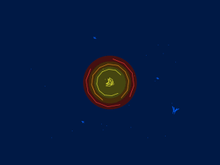Star Castle
| Star Castle | |
|---|---|
 | |
| Developer(s) | Cinematronics |
| Publisher(s) | Cinematronics |
| Designer(s) | Tim Skelly |
| Platform(s) | Arcade, Vectrex |
| Release date(s) | 1980 |
| Genre(s) | Multi-directional shooter |
| Mode(s) | Up to two players, alternating turns |
| Cabinet | Upright |
| Display | Vector, standard resolution, horizontal orientation |
Star Castle is a 1980 vector arcade game by Cinematronics. The game involves obliterating a series of defenses orbiting a stationary turret in the center of the screen. The game was designed by Tim Skelly and programmed by Scott Boden. Tim Skelly also created a number of other Cinematronics titles, including Starhawk, Armor Attack and Rip-Off. As with many other titles by the company, Star Castle was ported to the Vectrex video game console in 1983.
Gameplay

The object of Star Castle is to destroy an enemy cannon which sits in the center of three concentric, rotating energy shield rings while avoiding or destroying 'mines' – enemies that spawn from the core, pass through the energy rings, and then home in on the player's ship. They can stick back to the shield if the player maneuvers in such a way that a ring is between the ship and the mines. The player-controlled spaceship can rotate, thrust forward, and fire small projectiles. The cannon's shields are composed of twelve sections each, and each section takes two hits to destroy. Once a section is breached, rings beneath it are exposed to fire.
Once the innermost ring has been breached, the central weapon is vulnerable to attack from the player. However, the player is also more vulnerable at this point, as with the shield rings eliminated, the gun can fire out a large projectile that hisses with white noise. Moreover, the central core tracks player movement at all times. If the player manages to hit the cannon, it explodes violently, collapsing the remnants of the shield rings, and the player is awarded with an extra ship. The next level then starts with a new gun and fully restored shield rings, with the difficulty increased (the mines move faster, the rings rotate more quickly, and the core tracks the player faster).
If the player completely destroys the outermost shield ring, the cannon will create a new one. The middle ring expands to replace the lost outer ring, the inner ring replaces the middle, and a new ring emerges from the core to become the inner ring. Therefore, in order to penetrate the cannon's defenses, the player must be careful not to completely obliterate the outer ring.
The three homing mines will destroy the player's ship on contact. The mines can be destroyed, but they are very small and difficult to fire on, and the player does not receive points for destroying them. Mines are revived when shield rings regenerate (some variants keep three mines churning constantly so that a new mine respawns from the core as soon as one is destroyed). As the player progresses through the levels, the mines get faster and faster, forcing the player to keep moving to avoid them.
Design and development
The game is vector-based and monochrome; the colors of the rings and screen are provided by a transparent plastic screen overlay. As opposed to some games, the points will not roll over at 1 million (approximately four hours of game play). The development of the game was chronicled in an issue of the now-defunct magazine Science 80, without the knowledge of the designer or programmer of the game. Hence, it may be an inaccurate portrayal of the actual design and development of the game.
Legacy
- Star Castle was an inspiration for the Atari 2600's popular Yars' Revenge (1981).
- A level inspired by Star Castle is featured in Angry Birds Space.
- D. Scott Williamson adapted the original arcade version of Star Castle to the Atari 2600 game console, a task that was originally thought impossible by Howard Scott Warshaw, developer of Yars' Revenge. Completed in 2012, the Atari version was made available as a limited run physical cartridge complete with box art and instruction manual.[1]
Popular culture
- Star Castle was featured in the 1982 movie Fast Times at Ridgemont High.
- Star Castle can be seen in the 1982 movie Rocky III. In an opening scene where Paulie is walking in an arcade, a girl can be seen playing Star Castle.
- Star Castle was featured in the 1984 movie Ghostbusters. It was one of the two arcade games, along with a pinball machine, that the Ghostbusters team kept in their headquarters.
- Star Castle was featured in the 1986 movie Maximum Overdrive, where it electrocuted a person to death in the arcade.
- Star Castle was featured in the 1989 TV series Columbo: in the episode "Murder, Smoke and Shadows" along with the video game Joust.
References
- ↑ "Atari 2600 Star Castle Kickstarter Campaign". Retrieved 3 May 2012.